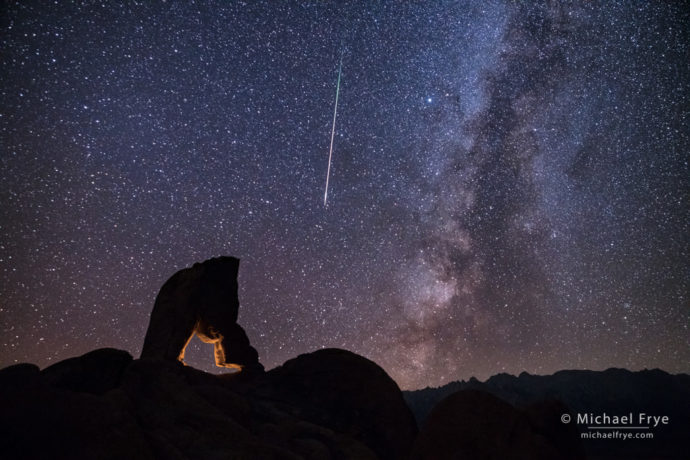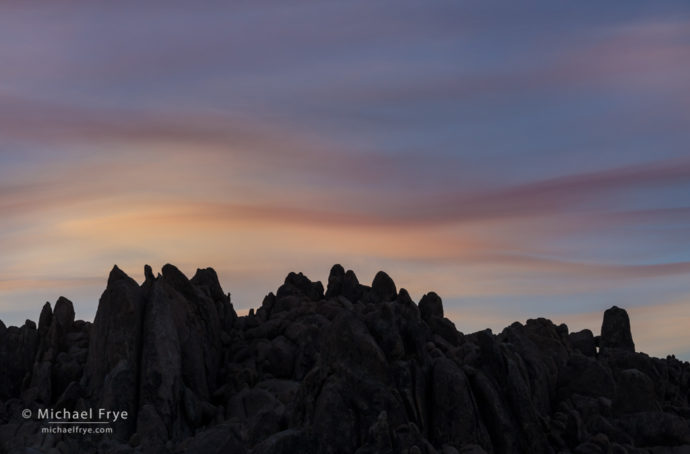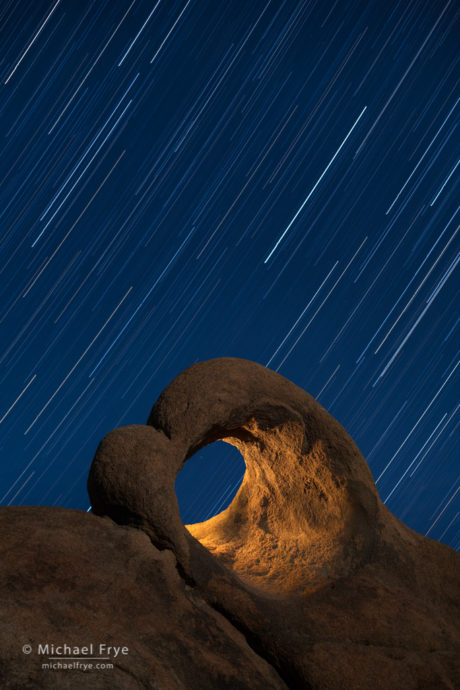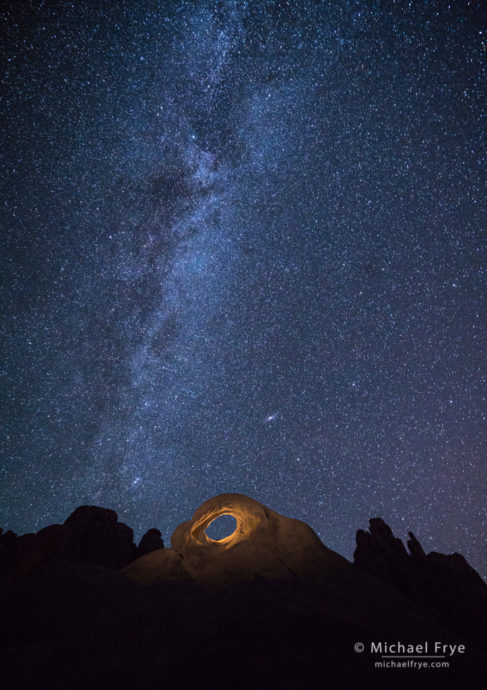
Arch, meteor, and the Milky Way, Alabama Hills near Lone Pine, California. 2:13 a.m. Thursday, August 11th.
After the workshops Claudia and I decided to head down to the Alabama Hills. I’ve been wanting to do some night photography there, and the Perseid meteor shower was nearing its peak. This is typically one of the best meteor showers of the year, but this year was supposed to be exceptionally good, with up to 200 meteors per hour during the peak time early Friday morning.
But even with that many meteors you need some luck to capture a bright one in the frame. I guess luck was with me in the Alabama Hills, because just after 2:00 a.m. Thursday morning a bright fireball lit up the sky to the southwest. I knew it was in my picture somewhere, but upon reviewing the photo I realized the meteor was perfectly placed, right between the small arch and the Milky Way.
Of course I did everything I could to maximize the odds of catching a bright meteor in the frame, but still, that placement was an extraordinary stroke of luck. I was jumping up and down when I saw the image appear on my LCD screen.
One way of maximizing the odds was by taking a continuous series of exposures (at my standard Milky Way settings of 15 seconds, f/2.8, 6400 ISO). I set the camera to continuous shooting mode and locked open the shutter button on my cable release, so that one exposure immediately followed another. Essentially the shutter was open all the time, so that if any meteor appeared within the frame the camera would capture it. By the time that bright meteor appeared the camera had been running for a little more than 30 minutes with that same composition – not really that long. But it was late, and I had been debating how long to keep the camera going before going to bed. When that meteor appeared and I saw its placement in the frame there was no more debate, because there was no chance of catching a better one. So I stopped the sequence, then lit the underside of the arch in a separate frame. The image you see above is a blend of those two frames – one with the stars, Milky Way, and meteor, plus the silhouetted arch and mountains, while the other frame just added some light to the arch.
I also tried to increase the odds of capturing a bright meteor by pointing the camera away from the “radiant.” You always hear that you’re supposed to look toward the radiant of a meteor shower – the part of the sky the meteors are coming from. For the Perseid meteor shower the radiant is the constellation Perseus, in the northeast part of the sky. It’s true that you’ll see more meteors by looking toward the radiant. But over the years I’ve noticed that the brightest, longest meteors, the ones that elicit the most oohs and ahs, almost always appear in a different part of the sky. When you’re looking at the radiant the meteors are coming right at you, so their streaks are short. When you look away from the radiant the meteors are grazing across the sky, so their streaks are longer, and they’re often more spectacular. In the photograph above I was looking southwest, away from Perseus.
Of course which direction you point the camera depends on what you’re trying to do. In this case I was just hoping to catch one bright meteor in the frame. But I’ve seen some wonderful images (like this one from Rick Whitacre) where the photographer pointed the camera toward the radiant, made a long series of exposures over many hours, and then blended parts of those images together to show the radiating pattern of the meteors.
I made more images earlier that night in the Alabama Hills, and I’ve included a few of those below. It was a really fun evening in a beautiful spot, and I look forward to going back there soon.
— Michael Frye
P.S. On the next night we hiked up to an alpine lake in Yosemite, hoping to photograph more meteors; I’ll post some images from that journey soon.

Smoke at sunset over the rocks of the Alabama Hills. A large swath of smoke from the Soberanes Fire in Big Sur drifted over the mountains just before sunset, forming these beautiful waves. Fortunately the skies cleared later that night.
Related Posts: Stars Over the Tuolumne River; Focusing in the Dark
Michael Frye is a professional photographer specializing in landscapes and nature. He is the author or principal photographer of The Photographer’s Guide to Yosemite, Yosemite Meditations, Yosemite Meditations for Women, Yosemite Meditations for Adventurers, and Digital Landscape Photography: In the Footsteps of Ansel Adams and the Great Masters. He has also written three eBooks: Light & Land: Landscapes in the Digital Darkroom, Exposure for Outdoor Photography, and Landscapes in Lightroom: The Essential Step-by-Step Guide. Michael has written numerous magazine articles on the art and technique of photography, and his images have been published in over thirty countries around the world. Michael has lived either in or near Yosemite National Park since 1983, currently residing just outside the park in Mariposa, California.











Hi Michael,
Remarkable photos! Absolutely stunning!
Thanks for sharing once again.
Cheers,
Alyn
Thank you Alyn!
Very awesome Mike. Thanks for sharing.
Thanks Joe!
Beautiful photos, Michael (as usual). When you essentially have the shutter open and the sensor “lit” for 30 minutes at ISO 6400, you’ll probably get quite some hot pixels – how do you deal with them? Or do you just not care about them? 🙂
Thanks Alex! I do care about hot pixels, but I didn’t get that many in these photos with my camera (Sony A7r II). Of course other cameras may produce more. You probably know this, but one possible solution is to take a dark frame periodically (just put the lens cap on and use the same shutter speed and ISO). You can layer that dark frame with one of the other photos in Photoshop, and change the blending mode of the dark frame to Difference. That probably won’t remove all the hot pixels, but should at least get some of them and make the cloning job easier.
Really beautiful photographs – a rare capture!
Thank you Chloe!
That first photo is definitely going to be in your top ten “significant” images of the year. Well done. Although I have to ask – I see more and more often in these blogs you “blending” several images together. You didn’t used to do that. At what point does this become “art” and not photography? Whatever happened to getting the image right In the camera to start with? A person could seemingly add in every element they wish into a photo making it a work of digital art. Not trying to be rude just genuinely asking .
Stunning image, Michael, many thanks!
Thanks Bob!
Great images, and congrats on capturing the meteor streak. Thanks for talking through your process and techniques. There’s a lot here I’ve not yet tried, but would like to: meteors, star trails, milky way, light painting. How much time do you spend scouting out a location in advance to find just the right foreground features, especially for shots that feature the milky way? Thanks!
Thanks very much Todd. How much time I spend scouting depends on a lot of factors. The most important one is how well I know the area to begin with. If I know it well I might not have to do any scouting; if the area is completely new to me then I’ll have to do quite a bit of scouting. If I haven’t been to an area before I’ll do some research, looking through guidebooks or online information and photos.
Michael,
You captured some extraordinary photos that bring exceptional life to desert arch formations and mystery to the celestial bodies. As always, thanks for the enjoyment and pure indulgence!
Very nice Ann – thank you!
Hi Michael!
I am going to be in Yosemite from sept 21 to the 24. Are you conducting a workshop on those dates?
Sorry Ana, we don’t have any workshops scheduled for those dates. Thanks for your inquiry!
Thanks. I would love to shoot with you some day. Please keep me posted.